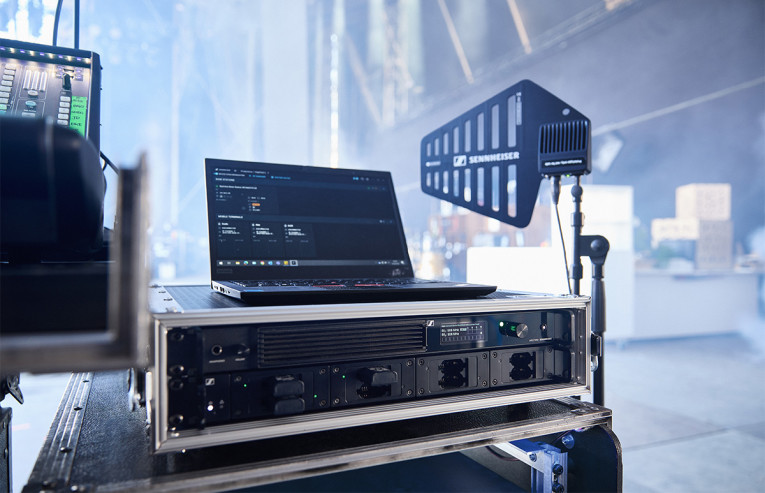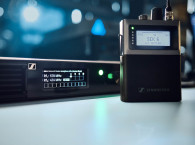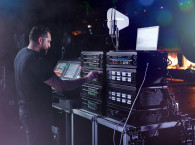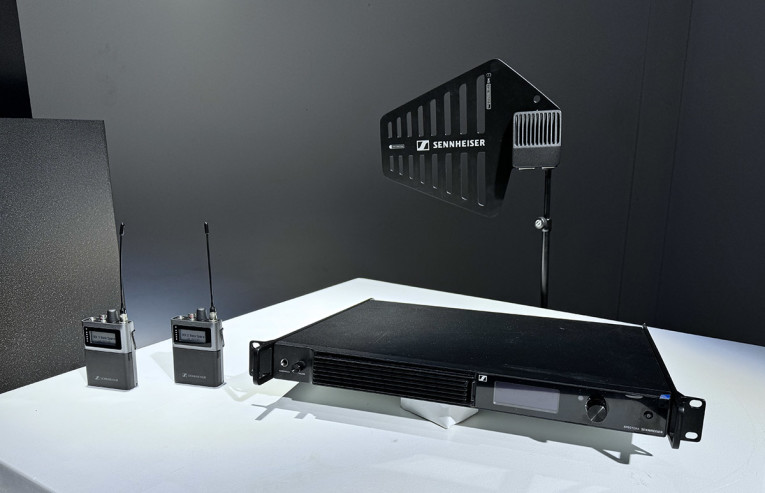
The introduction of Sennheiser Spectera is a major step for the German company, one of the pioneers in wireless microphone systems. Having been always at the forefront of the most important innovations in wireless audio, Sennheiser has devoted more than 10 years to the groundbreaking WMAS development and now reports a considerable strategic lead as it announces its first commercial available system.
Paving the way for a new era of digital wireless audio transmission with the world’s first bidirectional wideband solution, Spectera uses WMAS to reduces wireless system complexity and tackle the global problem of spectrum limitations. But more important, even this very first Sennheiser Spectera solution will considerably increase the use of wireless audio systems for professional applications, offering outstanding features such as full remote control and monitoring, including permanent spectrum sensing.

The world’s first wideband, bidirectional digital wireless ecosystem, Spectera will be available in a single 19" 1RU base station transceiver supporting a total of 64 channels (32-In/32-Out), operating with a total of 50 mW of transmit power per RF broadband channel, which is the equivalent of the transmit power of a single conventional wireless microphone today. With fully bidirectional communication between base station and the new hybrid mic/line transmitter/IEM receiver SEK bodypacks, a single system can work as a wireless microphone system, a wireless IEM system, or both, all managed through the LinkDesk software for desktop Mac/Windows.
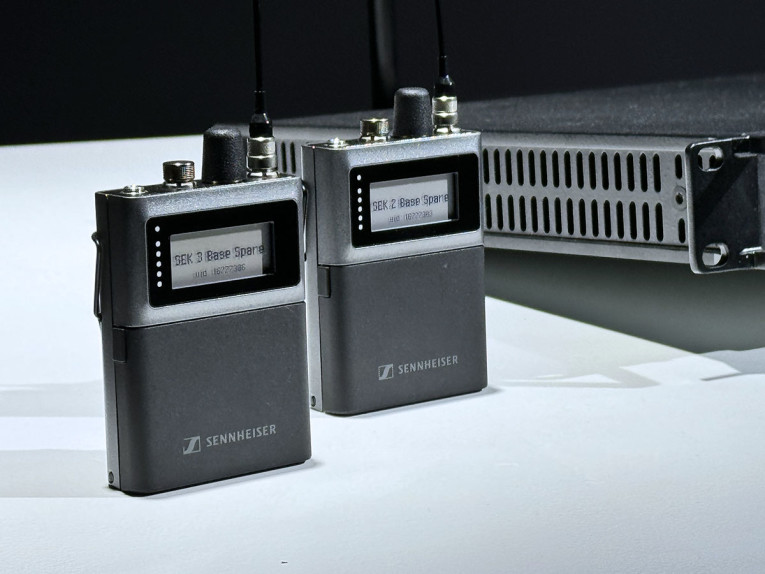
The first new Sennheiser Spectera Base Station works on 470 to 663MHz (UHF), and 1435 to 1525MHz (1GHz), using a 6/8 MHz carrier technology. The Spectera Base Station supports 48kHz and 96kHz audio modes with AES 256 encryption (audio and control), with redundant power, Dante networking and optional MADI connectivity. 4 redundant antenna ports are available to connect the first two Spectera antennas to allow for extended zone coverage and additional spectrum capacity.
The first available transmitters and receivers (the system is bidirectional allowing a single bodypack to support a microphone input and an IEM output) are the Sennheiser Spectera SEK UHF Bidirectional Wireless Bodypack Mic Transmitter/IEM Receiver, which connect with the Spectera Base Station. The Spectera SEK bodypacks feature a 3-pin LEMO mic-input connector, a 3.5mm IEM/IFB headphone connector, an always-on E-ink display and LED Meter, and a detachable antenna. Each SEK bodypack features a high-power headphone amplifier and supports up to 7 hours of operation on a BA-70 rechargeable battery (the same used in the Evolution Wireless Digital systems).
A key component in the Sennheiser Spectera is the IP 54 protected DAD transceiving antenna that manages mic/line signals, IEM signals, and control data, all at the same time. The antenna carries the RF components of the system, eliminating the need for boosters, splitters and combiners. The RF is digitized in the antenna, which does not use a BNC connector and coaxial cable for connection to the Base Station, but a ruggedized RJ 45 connector and CAT 5e cable instead. These cables are much easier to handle, more cost-effective, and not prone to cable losses, allowing the antenna to be powered by the Base Station via PoE. Sennheiser offers high-quality CAT 5e cables with lengths of 10m, 25m, and 50m. An interesting possibility is to use Layer 1 media conversion (base layer) to distribute the signals via optical fiber in order to cover larger venues.
WMAS Arrives
Multiple companies have been working on WMAS systems since Sennheiser announced its successful development program, enabling the first broadband applications, in February 27 2023. Broadband wireless technology supports multiple devices linked over the air in a single broadband RF channel with a bandwidth of 6 or 8MHz, the bandwidth of a TV channel. The audio engineer simply selects a carrier frequency for the broadband RF channel to be configured, and the system will coordinate itself, with the quality and range that the engineer chooses for the individual audio devices.
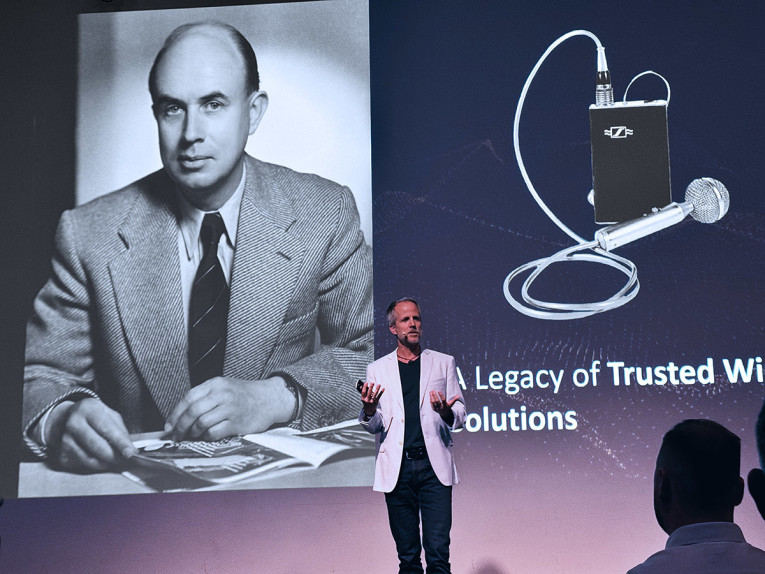
In August 2018, Sennheiser filed a Petition for Rulemaking with the FCC requesting a modification in the bandwidth limit specified for wireless microphones by the Commission. At that time, Sennheiser demonstrated a prototype system to the Commission's Office of Engineering & Technology (OET). During five and a half years, the FCC monitored further developments of WMAS technology and concluded that it justified the requested rule change. Already in February 2024 the FCC adopted WMAS technology, in alignment with the EN 300 422 standard, which was developed by ETSI (European Telecommunications Standards Institute).
Today, conventional narrowband wireless microphones are limited to operate in an RF bandwidth of 200kHz. Each audio channel uses a dedicated, mono-directional transmitter-receiver pair tuned to a unique RF carrier. Each transmitter continuously outputs power, typically 50 mW, which raises the RF noise floor with each channel that’s added to the configuration. These multiple carriers are also prone to generating non-harmonic distortion products, known as intermodulation (IM), which can interfere with wanted signals.
The benefits of WMAS technology are accomplished by multiplexing audio channels onto a wideband RF channel, which is 6MHz for the US in the case of Sennheiser’s WMAS technology. In this space, portable bidirectional transceivers will be able to communicate with a base station at an extremely low power spectral density. This will provide superior protection to nearby operators of other wireless devices.
Narrowband digital wireless microphones will continue to be used for applications where this integration is not required, or where only a few microphones are used, which means that WMAS and conventional systems will continue to coexist for quite some time. In fact, at IBC 2024, Sennheiser launched its latest generation EW-DX EM 4 Dante receiver, which completes the company's Evolution Wireless Digital EW-DX microphone offer. The network-ready, 4-channel receiver (19", 1U) is specified for live audio, touring, broadcasting, theatre, and system integration applications.
But WMAS will quickly take over highly demanding live performance and studio applications since it offers higher spectral efficiency by transmitting more audio channels within a limited block of radio frequency (RF) spectrum, and offers greater interference protection to other wireless services that share the same spectrum.
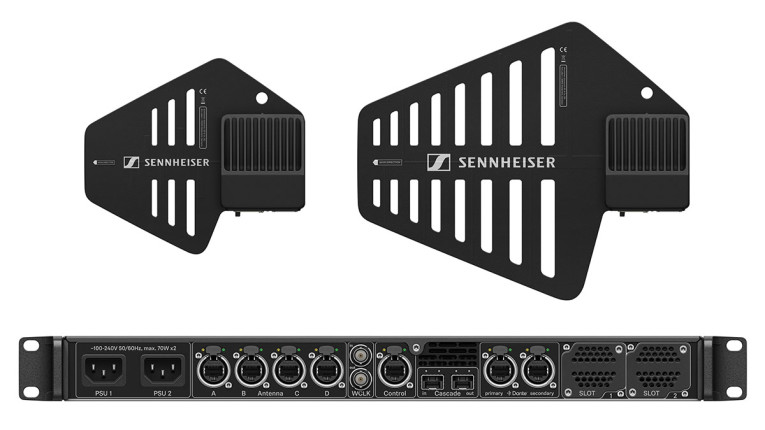
The Sennheiser Spectera WMAS Ecosystem
Since WMAS uses a single RF carrier, the possibility of intermodulation products is eliminated. For the first time, in-ear monitor channels will be able to use, in parallel, the same block of RF spectrum as wireless microphones, further enhancing spectral efficiency. Spectera features bidirectional bodypacks that manage both digital IEM/IFB and mic/line signals at the same time. The solution is remarkably resistant to RF fading and allows for flexible use of the wideband RF channel, for example for digital IEMs with a latency down to a spectacular 0.7 milliseconds.
"We are thrilled to see years of technological development and spectrum policy work turn into a digital wireless ecosystem that will solve many of the issues that users of wireless multichannel systems are faced with today," say co-CEOs Dr Andreas Sennheiser and Daniel Sennheiser. "Our wideband solution will be ideal for large productions, whether in the touring, broadcasting, or theater fields, or in any other area that requires multichannel audio setups. Spectera satisfies our customers’ chief desires and needs regarding ease of use, operational reliability and flexibility. It offers less hardware, drastically reduced frequency coordination, redundancy, and the flexibility of an ecosystem that grows with your needs."
Sebastian Georgi and Jan Watermann are the inventors of the specific Sennheiser approach to WMAS. The technology they developed is a proprietary variant of OFDM-TDMA, specifically tailored to reliable multichannel, bidirectional, low-latency communication. They succinctly compare this wideband approach to standard narrowband technology: "Instead of many individual 200 kHz narrowband RF carrier frequencies, we use a single wideband RF channel for audio transmission – bidirectional transmission of audio and control data, to be more exact. In Sennheiser’s approach, the wideband RF channel is a TV channel of 6 or 8MHz, depending on local regulations.
The WMAS system organizes its audio links within this channel. Every audio link, be it a mic or an IEM, is assigned specific time slots for transmitting its audio information – for the first time, it is possible to have IEMs and mics in the very same TV channel instead of two channels separated by a guard band. Thanks to the fact that all audio links use the full width of the RF channel when it’s ‘their turn’, RF fading is greatly reduced. It corresponds to 40-fold diversity for an 8MHz RF channel and 30-fold diversity for a 6MHz TV channel. Also, the spectral density is low, which makes it easier to reuse frequencies, for example on a larger festival ground, between neighboring theaters, or in a broadcasting complex.

Spectera also represents a total shift in control and monitoring, with its continuous two-way communication implementation. Through a permanent control data stream, audio settings can be adjusted, IEM and mic levels adapted, RF health and battery status monitored, and much more. AES 256 encryption (AES 256 CTR Mode with >10kYears expiry) for both audio and control data ensures the necessary data privacy. Also, all units help in continuously sensing the spectrum, meaning they scan for potential interference from other RF sources.
Spectera delivers digital audio quality for microphones, instruments and IEMs, employing different application-optimized audio codecs, which are all internally processed with 32-bit-float precision. Eleven Audio Link Modes allow for selectable control of audio quality, latency, channel count, and operating range for each and every audio link, flexibly throughout a production. The operator can always use the RF channel to the maximum, either by giving fewer audio links a high quality or by allowing more links and reducing the quality accordingly.
No matter which Audio Link Mode gets selected, Spectera offers the highest level of audio quality, critical for IEM, and with ultra-low latency down to 0.7 milliseconds. Dual Mono transmission also ensures a clean separation of the in-ear channels, enhancing the sound stage for optimal performance.
If the Base Station is the heart of the Spectera ecosystem, the all-new LinkDesk software is its backbone. The desktop application runs on Mac or PC and turns it into a remote control and monitoring center. Here, the operator can flexibly choose between the Audio Link Modes with their varying levels of audio quality, latency, possible audio links and range, as well as fully remote control, and monitor the entire system, with visibility of all audio settings and RF statuses.
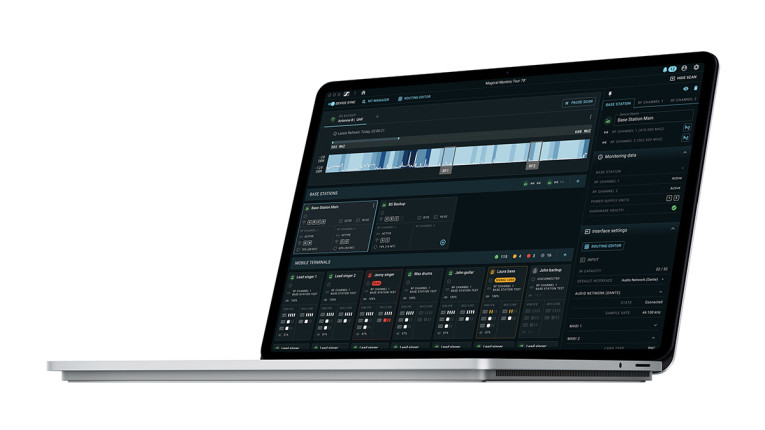
Spectera Availability
Sennheiser is now taking pre-orders for Spectera systems, with shipping expected for 2025. After these first WMAS solutions become available (availability will be ramping globally through 2025), Sennheiser intends to release an SKM-compatible handheld transmitter and gradually expand its software features. Spectera will evolve over time with continuous hardware, software, feature and service enhancements. Sennheiser confirmed that implementation of the SMPTE ST 2110 family of network standards for the transmission of professional media signals is in the plan, which can be achieved now using a Hapi multichannel interface from Merging Technologies.
"Spectera will not only revolutionise multichannel wireless audio, but also open up many new opportunities," says Andreas Sennheiser. "3D immersive audio is one such opportunity. Thanks to its synchronized word clock for all audio over RF, Spectera will be the first solution that is able to capture phase-coherent wireless audio for immersive recording and reproduction."
www.sennheiser.com
